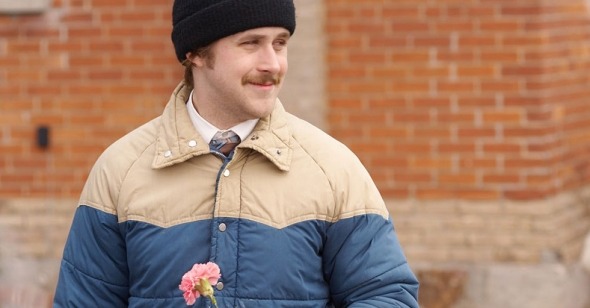Doll Parts
By Michael Koresky
Lars and the Real Girl
Dir. Craig Gillespie, U.S., MGM
In Lars and the Real Girl, Ryan Gosling gives an expectedly inward, gently mannered performance as Lars, a devastatingly closed-off, lonely twentysomething who lives in a garage behind the house of his brother, Gus, and sister-in-law, Karin, and works in one of those faceless, soulless cubicled offices that’s become the standard for big-screen drudgery. Though Lars comes across as something of a sweetly standoffish innocent, his recurrent, pained eye twitches and pathological inability to join Karin and Gus for a home-cooked meal point toward a more profound inner torment. Seemingly paralyzed by the fear of integrating with society, Lars retreats even further—into a delusional state. This is manifest when he orders a life-sized, plastic female doll online, names her Bianca, and begins to envision her as a viable, living romantic partner.
Lest this all sound like a Farrelly Brothers-esque comedy of mortification, it should be noted that the defiantly sober script (by Six Feet Under’s Nancy Oliver) and direction (by Craig Gillespie) refuse to adhere to the tenets of either absurdist comedy or crude jocularity. Not only is Lars never caught (or even shown) with his pants down while mounting the mannequin, he also remains ever-chaste, imagining Bianca as a good-girl fiancée with whom he will wait for marriage. Additionally, Lars does not keep Bianca a dirty little secret, stashing her away from family and co-workers; instead, Oliver needs us to swallow that Lars’s delusions run so deep that he willingly introduces Bianca around as though everyone else sees her the same way he does. Reaction from the tight-knit northern Midwest community is surprisingly accepting, even proud and contented; and ultimately, Lars’s burgeoning relationship with his silicone mistress, and its attendant ups and downs, is meant to stand in for a rather commonplace rite of passage.
There’s no denying that Lars and the Real Girl’s defiantly good nature comes as something of a refresher, especially given that the oddball subject matter would normally be exploited for gross-out gags. Yet as a result, Lars feels wholly neutered, a wishful-thinking portrait of a reliably lovable outcast, who not only is almost entirely embraced in his antisocial behavior but also never comes up against much conflict. Therefore, the film’s nearly Pollyanna-ish outcome—in which a town bands together in a show of epic enabling and a stunted man-child learns about personal growth—is practically a given, and the film moves along a steady, inoffensive track to a feel-good outcome.
But embracing, or even idolizing, madness has been a narrative stock-in-trade for many years (Cuckoo’s Nest, Benny & Joon), as both a way to symbolize the individual skirting societal expectations and a means to question, “What is true normalcy?” These issues have been plumbed with greater depths and less absurdist cutesiness in other fictions, but Lars does offer its own small pleasures, from Gillespie’s delicate direction, which lovingly evokes a midwinter atmosphere of hushed sunlight and snow, to terrific supporting turns from Paul Schneider and Emily Mortimer as Gus and Karin, the most conflicted of Lars’s ostensible supporters. It’s their startled compassion that holds the film together, and thanks to Schneider’s searching, moving delivery, a late-film speech about what it means to “be grown up” manages to sound spontaneous, genuine, and unwritten.
